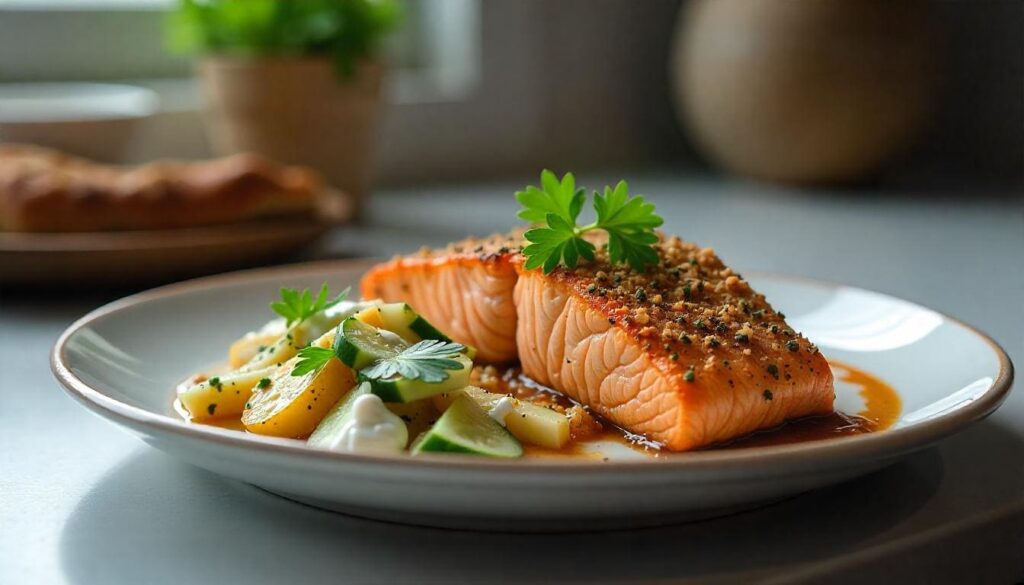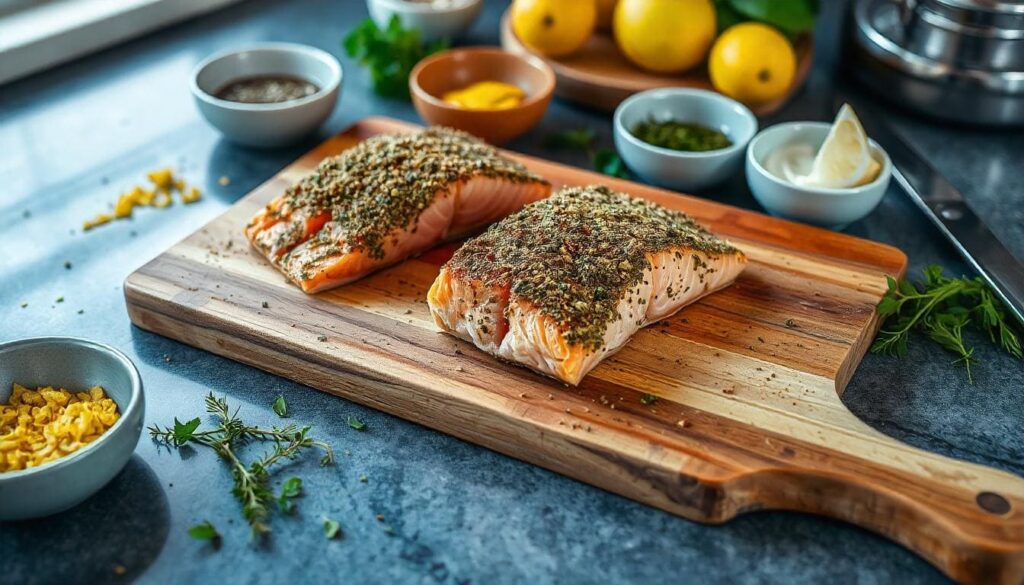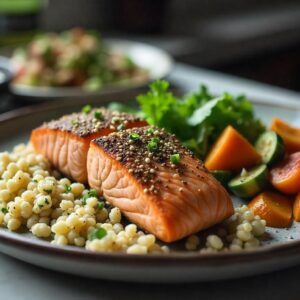
Salmon is a staple in many kitchens, and for good reason! It’s a versatile fish that’s as healthy as it is delicious. Known for its rich flavor and tender texture, salmon has gained a global following. Now, imagine pairing that incredible fish with za’atar—a fragrant, tangy Middle Eastern spice blend. Together, they create za’atar crusted salmon, a culinary masterpiece that’s bursting with flavor and packed with nutrients.
Za’atar, with its earthy and slightly nutty profile, has been a cornerstone of Middle Eastern cuisine for centuries. This za’atar crusted salmon recipe is perfect for anyone looking to combine bold Middle Eastern flavors with a healthy, easy-to-make dish. Ready to learn more? Let’s dive into what makes this dish so special!
What is Za’atar?
Definition and Origin of Za’atar
Za’atar is more than just a spice blend—it’s a cultural treasure. Its roots trace back to the Middle East, where it’s used as a seasoning, a condiment, and even a health remedy. The name “za’atar” refers to both the blend itself and a type of wild thyme native to the region.
Common Ingredients in Za’atar Blends
The beauty of za’atar lies in its simplicity. While recipes vary, most blends include dried thyme, oregano, marjoram, sesame seeds, sumac, and salt. Sumac gives za’atar its signature tangy kick, while sesame seeds add a nutty crunch. These ingredients come together in perfect harmony, creating a versatile spice that can elevate just about any dish.
Culinary Uses of Za’atar
Za’atar is a true multitasker in the kitchen. It’s sprinkled on flatbreads, mixed into olive oil for dipping, or used to season roasted vegetables. But its magic truly shines when it meets salmon. The bold, herbal notes of za’atar enhance the natural flavors of the fish, making each bite an unforgettable experience.
Health Benefits of Salmon
Nutritional Profile of Salmon
Salmon is a nutritional powerhouse. It’s loaded with high-quality protein, essential vitamins like B12 and D, and an array of minerals, including selenium and potassium. Whether you’re looking to support muscle growth or maintain a healthy immune system, salmon has you covered.
Omega-3 Fatty Acids and Their Benefits
Perhaps the most famous nutrient in salmon is its omega-3 fatty acids. These healthy fats are known for their anti-inflammatory properties, which can help reduce the risk of heart disease, improve brain function, and even support joint health. Plus, omega-3s are great for glowing skin and shiny hair—bonus!
Incorporating Salmon Into a Balanced Diet
Adding salmon to your meals is one of the easiest ways to boost your nutrition. Bake it, grill it, or pan-sear it—you can’t go wrong. And when you pair it with za’atar, you’re not just making a meal; you’re creating a feast for your taste buds and your body.
Why Combine Salmon and Za’atar?
Flavor Profiles: How Za’atar Complements Salmon
Za’atar’s tangy and herbaceous flavor is the perfect match for salmon’s richness. The spice blend cuts through the natural oils of the fish, adding a zesty layer that enhances every bite. The sesame seeds in za’atar also provide a delightful crunch, creating a texture contrast that’s simply irresistible.
Cultural Significance of Combining These Ingredients
The pairing of salmon and za’atar isn’t just a modern culinary trend; it’s a nod to the fusion of global flavors. Za’atar has been used in Middle Eastern cooking for centuries, and combining it with salmon—often found in Mediterranean and Nordic cuisines—bridges cultural divides to create something truly special.
Popularity of This Combination in Contemporary Recipes
In recent years, chefs and home cooks alike have embraced the za’atar-and-salmon duo. It’s a hit at dinner parties, a favorite for meal prep, and a go-to for anyone looking to impress with minimal effort. This pairing is proof that simple ingredients, when combined thoughtfully, can create extraordinary results.
Selecting the Right Salmon
Differences Between Wild-Caught and Farm-Raised Salmon
Choosing the right salmon can make all the difference. Wild-caught salmon is prized for its robust flavor and leaner texture. It’s typically higher in omega-3s and free from added antibiotics. On the other hand, farm-raised salmon is often more affordable and available year-round, with a milder taste that some people prefer.
Tips for Purchasing Fresh, High-Quality Salmon
When shopping for salmon, freshness is key. Look for fillets that are firm, moist, and vibrant in color. If it smells overly “fishy,” it’s best to pass. For whole fish, check the eyes—they should be clear, not cloudy. Buying from a trusted fishmonger or seafood counter is always a good idea.
Sustainable Seafood Choices
Sustainability matters, too. Overfishing and environmental impact are concerns when it comes to seafood. Look for certifications like the Marine Stewardship Council (MSC) label or ask your supplier about the sourcing. Opting for sustainable choices ensures that future generations can enjoy delicious seafood just like you.
Making Your Own Za’atar at Home
Simple Recipe for Homemade Za’atar

Why settle for store-bought when you can easily make za’atar at home? A basic za’atar recipe involves mixing the following ingredients:
- 2 tablespoons dried thyme
- 1 tablespoon ground sumac
- 1 tablespoon roasted sesame seeds
- ½ tablespoon dried oregano
- ¼ teaspoon sea salt
Toast the sesame seeds lightly in a pan to bring out their nutty flavor, then combine all the ingredients in a small jar. Give it a good shake, and voilà—your homemade za’atar is ready to shine.
Adjusting the Blend to Suit Personal Taste
Za’atar is wonderfully customizable. If you like a tangier flavor, add more sumac. For a nuttier touch, increase the sesame seeds. You can even experiment with dried marjoram or mint for a unique twist. The beauty of homemade za’atar lies in its adaptability.
Storing and Preserving Za’atar for Longevity
Keep your za’atar fresh by storing it in an airtight container, away from heat and moisture. It can last up to six months, though the flavors are best in the first three months. A cool, dark pantry or spice drawer is the ideal spot.
Recipe: Za’atar Crusted Salmon
Ingredients List
Here’s what you’ll need to whip up this crowd-pleasing dish:
- 4 salmon fillets (about 6 ounces each)
- 3 tablespoons za’atar
- 2 tablespoons olive oil
- 1 teaspoon lemon zest
- Salt and pepper, to taste
Step-by-Step Preparation Instructions
- Preheat your oven to 400°F (200°C). Line a baking sheet with parchment paper.
- Prepare the salmon by patting the fillets dry with a paper towel. Season both sides with salt and pepper.
- Create the za’atar crust by mixing the za’atar and olive oil in a small bowl until it forms a paste. Add the lemon zest for a bright, citrusy kick.
- Coat the salmon by spreading the za’atar paste evenly over the top of each fillet.
- Bake the salmon for 12-15 minutes, or until the fish flakes easily with a fork. For a crispier crust, broil for an additional 1-2 minutes.
Cooking Tips for Perfect Results
- Use a meat thermometer to ensure the salmon reaches an internal temperature of 145°F (63°C).
- Avoid overcooking by checking the salmon a minute or two before the suggested time.
- Let the salmon rest for a few minutes after removing it from the oven to lock in moisture.
For a masterclass in salmon preparation, learn from the best with this breakdown of how Gordon Ramsay cooks salmon. His tips and techniques are sure to inspire your own culinary creations and help you nail the perfect za’atar-crusted salmon.
Serving Suggestions
Side Dishes That Pair Well with Za’atar Crusted Salmon
Za’atar-crusted salmon shines when paired with light, fresh sides. For more inspiration on Mediterranean flavors, check out this Mediterranean salmon recipe. It’s a delightful way to explore how salmon pairs beautifully with herbs and spices from the region, just like our za’atar-crusted salmon.
Wine and Beverage Pairings
A crisp white wine like Sauvignon Blanc or a fruity Rosé pairs wonderfully with za’atar salmon. If you prefer non-alcoholic options, try a sparkling water infused with lemon or mint.
Presentation Ideas for an Appealing Meal
Make your dish Instagram-worthy by garnishing the salmon with fresh parsley and a sprinkle of za’atar. Serve it on a large platter with sides arranged around the fillets for a family-style feast.
Variations and Adaptations
Alternative Cooking Methods: Grilling, Baking, or Pan-Searing
Za’atar salmon is versatile enough to cook in various ways. If you’re curious about perfecting your cooking techniques, don’t miss this guide to the best cooking styles for salmon. Whether you bake, grill, or pan-sear, this resource will help you achieve flawless results every time.
Substituting Other Fish or Proteins with Za’atar Seasoning
Don’t have salmon? No problem! Za’atar pairs beautifully with cod, halibut, or even chicken breast. Tofu or portobello mushrooms are excellent vegetarian options.
Incorporating Za’atar Salmon Into Salads or Wraps
Transform your za’atar salmon into a fresh salad by flaking it over mixed greens, cucumbers, and cherry tomatoes. Add a drizzle of tahini dressing for extra flavor. Alternatively, tuck the salmon into a warm pita with hummus, pickled onions, and arugula for a Mediterranean-inspired wrap.
Tips for Cooking with Za’atar
Best Practices for Seasoning and Marinating
Za’atar’s bold flavor means a little goes a long way. Wondering how to bring out the best flavors in your salmon? Discover expert tips in this article on how to season salmon. It’s a must-read for anyone looking to elevate their dishes with bold, complementary flavors.
Heat Considerations to Preserve Za’atar’s Flavor
Heat considerations are also important to preserve za’atar’s unique taste. For more insights, you might want to explore this comparison of cooking methods. It highlights the pros and cons of different techniques, helping you decide whether to pan-fry or oven-cook your salmon.
Creative Uses of Za’atar in Other Recipes
Za’atar isn’t just for salmon! Use it to season roasted potatoes, sprinkle it over avocado toast, or mix it into yogurt for a quick dip. You can even add a pinch to scrambled eggs for a flavorful breakfast twist.
Exploring Middle Eastern Flavors
Introduction to Other Middle Eastern Spices and Herbs
Za’atar is just the beginning of the rich tapestry of Middle Eastern spices. Sumac, with its tangy and lemony profile, is a star in many dishes. Then there’s baharat, a warm and aromatic spice blend used in stews and rice dishes. Don’t forget about harissa, a fiery chili paste that adds heat and depth to any recipe. Incorporating these flavors alongside za’atar can create a truly immersive dining experience.
Complementary Dishes to Serve Alongside Za’atar Salmon
Pair your za’atar salmon with dishes that highlight Middle Eastern cuisine, such as:
- Tabbouleh: A refreshing parsley and bulgur salad with tomatoes and lemon juice.
- Baba ghanoush: A smoky eggplant dip that pairs beautifully with salmon.
- Pita bread: Warm, fluffy pita is perfect for scooping up every last bite of salmon and side dishes.
Resources for Sourcing Authentic Middle Eastern Ingredients
For the best za’atar and other Middle Eastern spices, check your local Mediterranean market or online specialty stores. Brands like Sadaf and Ziyad offer high-quality options. For a truly authentic touch, look for small-batch or region-specific za’atar blends from Lebanon, Syria, or Palestine.
Health Considerations
Allergen Information Related to Za’atar Ingredients
While za’atar is generally safe for most people, those with sesame allergies should exercise caution, as sesame seeds are a key ingredient. Always check the label of store-bought blends to avoid cross-contamination or unexpected allergens.
Dietary Modifications for Specific Health Needs
Za’atar salmon can easily be adapted for different diets. Use gluten-free za’atar for those with celiac disease or gluten sensitivity. Opt for low-sodium salt alternatives to make it heart-healthier. For keto diets, pair it with low-carb sides like cauliflower rice.
Portion Control and Balanced Meal Planning
While salmon is nutritious, portion size is important to maintain a balanced diet. A typical serving size is 3-4 ounces of cooked salmon. Combine it with plenty of veggies and whole grains to create a meal that’s both satisfying and healthy.
Frequently Asked Questions
- Can I use store-bought za’atar instead of making my own?
Absolutely! Store-bought za’atar works just as well. Look for high-quality blends with no added preservatives for the best flavor. - What other proteins work well with za’atar seasoning?
Za’atar pairs beautifully with chicken, lamb, tofu, and even eggs. It’s a versatile spice that elevates any protein. - How can I tell when my salmon is perfectly cooked?
The salmon should flake easily with a fork and have an internal temperature of 145°F (63°C). The flesh will be opaque and tender. - Is za’atar gluten-free?
Traditional za’atar is gluten-free, but some blends include wheat or gluten-based fillers. Always check the label to be sure. - Can I freeze za’atar-crusted salmon?
Yes! Cooked za’atar salmon freezes well. Let it cool completely, wrap it tightly, and store it in the freezer for up to three months.
Za’atar-crusted salmon isn’t just a meal; it’s a culinary journey. This dish brings together the robust, nutrient-rich goodness of salmon and the vibrant, aromatic charm of za’atar, creating a delightful fusion of flavors and cultures. Whether you’re a seasoned cook or just starting out, this recipe is simple, approachable, and endlessly satisfying.
By exploring the world of Middle Eastern spices, you open the door to new flavors and unforgettable dining experiences. So why not give this za’atar salmon recipe a try? You’ll not only impress your family and friends but also discover the magic of combining wholesome ingredients with a touch of vibrant flair.

The Best Za’atar Crusted Salmon Recipe You’ll Ever Try
Ingredients
For the Salmon
- 4 salmon fillets about 6 ounces each, skin-on or skinless
- 3 tablespoons za’atar
- 2 tablespoons olive oil
- 1 teaspoon lemon zest
- ½ teaspoon salt
- ¼ teaspoon black pepper
For Garnish
- 1 tablespoon fresh parsley or cilantro chopped
- Lemon wedges for serving
- Drizzle of extra virgin olive oil
Instructions
Step 1: Preheat the Oven
- Preheat your oven to 400°F (200°C).
- Line a baking sheet with parchment paper or lightly grease it with olive oil.
Step 2: Prepare the Salmon
- Pat dry the salmon fillets with a paper towel to remove excess moisture.
- Season each fillet lightly with salt and black pepper.
Step 3: Create the Za’atar Crust
- In a small bowl, mix za’atar, olive oil, and lemon zest to form a paste.
- Spread the za’atar mixture evenly over the top of each salmon fillet, pressing gently to adhere.
Step 4: Bake the Salmon
- Arrange the salmon fillets on the prepared baking sheet.
- Bake for 12-15 minutes, or until the salmon flakes easily with a fork and reaches an internal temperature of 145°F (63°C).
- For a crispier crust, broil the salmon for an additional 1-2 minutes at the end.
Step 5: Garnish and Serve
- Sprinkle with chopped fresh parsley or cilantro.
- Serve with lemon wedges and drizzle with extra virgin olive oil for extra richness.
- Enjoy with your favorite Mediterranean side dishes (see suggestions below).
Serving Suggestions
- ✔ Best Side Dishes:
- Mediterranean Couscous Salad (with cucumber, cherry tomatoes, and feta)
- Roasted Vegetables (zucchini, bell peppers, and eggplant)
- Garlic Herb Quinoa for a protein-packed option
- Hummus & Pita Bread for an authentic touch
- ✔ Wine Pairings:
- White Wine: Sauvignon Blanc or Pinot Grigio (light & citrusy)
- Red Wine: Grenache or Pinot Noir (light-bodied with fruity notes)
- ✔ Sauce Pairings:
- Tahini Sauce for a creamy, nutty addition
- Garlic Yogurt Sauce to complement the Mediterranean flavors
- Balsamic Glaze for a tangy-sweet contrast
Nutrition Per Serving (Based on 4 servings)
- Calories: 350 kcal
- Protein: 40g
- Fat: 18g
- Carbohydrates: 4g
- Fiber: 1g
Variations & Customizations
- ✔ Grilled Za’atar Salmon:
- Preheat a grill to medium-high heat (400°F).
- Grill the salmon for 4-5 minutes per side, until cooked through.
- ✔ Pan-Seared Za’atar Salmon:
- Heat 1 tablespoon olive oil in a skillet over medium heat.
- Cook salmon skin-side down for 4-5 minutes, then flip and cook for another 2-3 minutes.
- ✔ Vegetarian Alternative:
- Swap salmon for za’atar-crusted tofu or portobello mushrooms for a plant-based version.
- ✔ Spicy Kick:
- Add ½ teaspoon red pepper flakes or smoked paprika to the za’atar mix.
- ✔ Gluten-Free & Keto-Friendly:
- This recipe is naturally gluten-free and low-carb. Serve with cauliflower rice for a keto meal.
Pro Tips for the Best Za’atar Salmon
- ✔ Use High-Quality Za’atar: Authentic Middle Eastern za’atar makes a huge difference. Look for brands with sumac and sesame seeds for the best flavor.
- ✔ Don’t Overcook the Salmon: Salmon is best at 145°F (63°C). Use a meat thermometer to ensure perfect doneness.
- ✔ Let It Rest: After baking, let the salmon rest for 3-5 minutes before serving. This locks in moisture.
- ✔ Pair with Fresh Ingredients: Serve with lemon, fresh herbs, or yogurt sauce to enhance the Mediterranean flavors.
FAQs
- ❓ Can I use store-bought za’atar?
- Yes! Just make sure it’s a high-quality blend with sumac and sesame seeds.
- ❓ What’s a good substitute for za’atar?
- Mix dried thyme, oregano, sesame seeds, and sumac to create a homemade version.
- ❓ Can I meal-prep this recipe?
- Yes! Store cooked salmon in an airtight container in the fridge for up to 3 days.
- ❓ How do I reheat leftovers?
- Oven: Warm at 300°F (150°C) for 5-7 minutes.
- Stovetop: Reheat in a pan over low heat with a little olive oil.
- Microwave: Heat in 20-second intervals to avoid overcooking.
- ❓ Can I freeze za’atar-crusted salmon?
- Yes! Let it cool, wrap it in plastic wrap, and freeze for up to 3 months.
